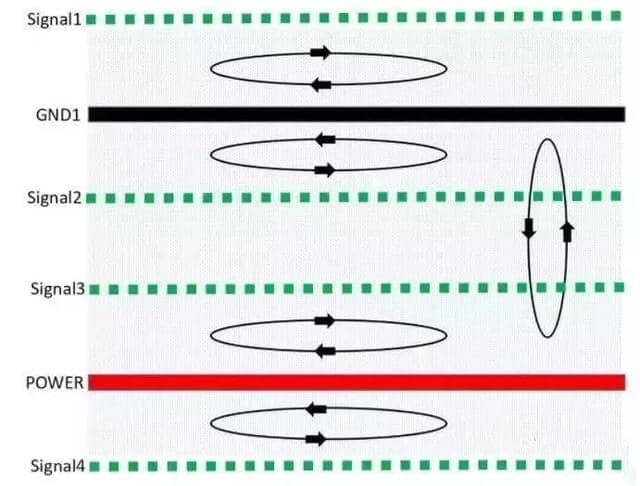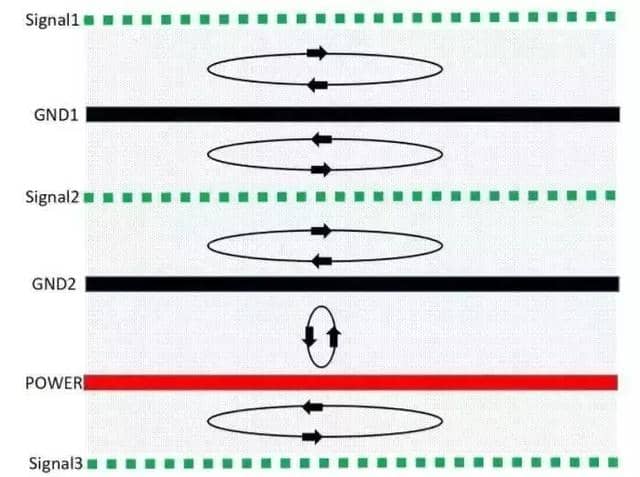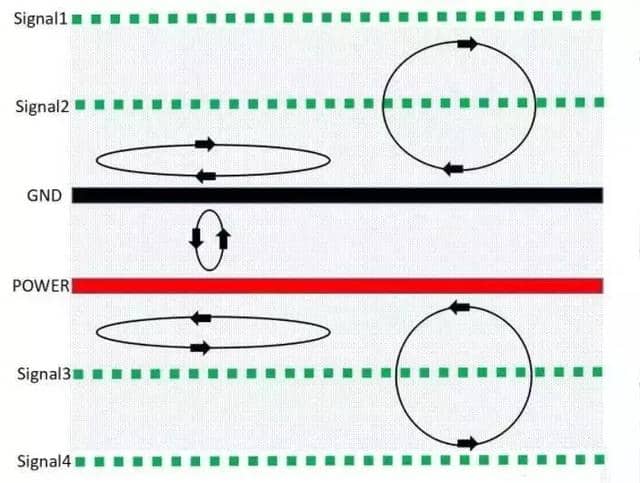
In the EMC design of the PCB, the first important thing is the setting of the layers. The number of layers of the single board is composed of the number of power, ground, and signal layers. You need to arrange them according to the requirements and needs. Once you are done with the setting of the layers, you can go to the next step.
In the EMC design of the product, in addition to the selection of components and the circuit design, Good PCB design is also a critical factor. You need to make sure that the PCB is perfectly designed to offer optimal performance. The key to PCB EMC design is to reduce the reflow area as much as possible so that the reflow path flows in the direction we have designed.
The layered design is the basis of the PCB. But how does the PCB layer design do an excellent job of making the PCB’s EMC effect optimal? Let’s discuss
The Design Idea of PCB Layer
The core of PCB stack EMC planning and design thinking is to plan the signal return path reasonably. It plans to minimize the signal return area from the mirror layer of the single board so that the magnetic flux can be canceled or minimized.
a) Single Board Mirroring Layer
The mirror image layer is a complete copper-clad plane layer (power, ground layer) inside the PCB. It is adjacent to the signal layer. The main functions of this layer are as follows:
(1) Reduce Return Noise: The mirror layer can provide a low impedance path for the signal to return. When there is a large current flowing in the power distribution system, the role of the mirror layer is more prominent.
(2) Reduce EMI: The existence of the mirror layer reduces the area of the closed-loop formed by the signal and reflow. It also reduces EMI.
(3) Reduce Crosstalk: It is helpful to control the crosstalk problem between signal traces in high-speed digital circuits. By changing the height of the signal line from the mirror layer, the crosstalk between the signal lines can be controlled. The smaller the height, the smaller the crosstalk.
(4) Impedance control to prevent signal reflection.
b) The Choice of Mirroring Layer
(1) Power and ground planes can be used as reference planes and have a specific shielding effect on internal wiring.
(2) Relatively speaking, the power plane has a high characteristic impedance, and there is a significant potential difference with the reference level. The high-frequency interference on the power plane is relatively large.
(3) From the perspective of shielding, the ground plane is generally grounded and used as a reference power plane reference point, and its shielding effect is far better than that of the power plane.
(4) When selecting the reference plane, the ground plane should be preferred, and the power plane should be selected if the ground plane is not available.
Principle of Magnetic Flux Cancellation
According to Maxwell’s equation, all electrical and magnetic interactions between separate charged bodies or currents are transmitted through the intermediate area between them, regardless of whether it is a vacuum or a physical substance.
In the PCB, the magnetic flux always propagates in the transmission line. If the RF return path is parallel to its corresponding signal path, the magnetic flux on the return path and the magnetic flux on the signal path are in opposite directions. At this time, they are superimposed on each other, and the effect of flux cancellation is obtained.
The essence of magnetic flux cancellation is the control of the signal return path. The specific schematic diagram is as follows:
You might be thinking about how to use the right-hand rule to explain the effect of magnetic flux cancellation when the signal layer is adjacent to the ground layer. The explanation is as follows:
(1) When a current flows through the wire, a magnetic field is generated around the wire, and the right-hand rule determines the direction of the magnetic field.
(2) When there are two parallel wires close to each other, the current of one conductor flows out, and the current of the other conductor flows in. If the current flowing through the two wires are the signal current and its return current, respectively, Then the two currents are equal in magnitude and opposite in direction. Therefore, their magnetic fields are also equal in size, but in opposite directions, so they can cancel each other.
Six-layer PCB Board Design Examples
| Solutions | Power | GND | Signal | 1 | 2 | 3 | 4 | 5 | 6 |
| 1 | 1 | 1 | 4 | S1 | G | S2 | S3 | P | S4 |
| 2 | 1 | 1 | 4 | S1 | G2 | G | P | S3 | S4 |
| 3 | 1 | 2 | 3 | S1 | G1 | S2 | P | G2 | S3 |
| 4 | 1 | 2 | 3 | S1 | G1 | S2 | G2 | P | S3 |
| G: GND, Ground, S: Signal Layer, P: Power | |||||||||
Four solutions for 6-layer PCB stack design
a) For a Six-layer Board, Priority is Given to Solution 3:
Analysis:
(1) Since the signal layer is adjacent to the reflux reference plane, and S1, S2, and S3 are adjacent to the ground plane, there is the best magnetic flux cancellation effect. The wiring layer S2 is preferred, followed by S3 and S1.
(2) The power plane is adjacent to the GND plane, and the distance between the planes is small, which has the best magnetic flux cancellation effect and low power plane impedance.
(3) The main power supply layer and its corresponding grounding layer are arranged on the 4th and 5th layers. When setting the layer thickness, increase the spacing between S2-P and reduce the spacing between P-G2 (correspondingly reduce the spacing between G1-S2 layers) to reduce the impedance of the power plane and reduce the impact of power on S2.
b) When Low Cost is Required, Solution 1 Can Be Selected
Analysis:
(1) In this type of stacking, since the signal layer is adjacent to the reflux reference plane, S1 and S2 are close to the ground plane. Therefore, it has the best magnetic flux cancellation effect.
(2) Since the power plane passes through S3 and S2 to the GND plane, the magnetic flux cancellation effect is poor, and the power plane impedance is high.
(3) The circuit layers S1 and S2 are preferred, followed by S3 and S4.
c) Solution 4 is An Alternative to the 6-layer PCB Design
Analysis:
For occasions with high local and small-signal requirements, Solution 4 is more suitable than Solution 3 because it can provide an excellent wiring layer S2.
d) Solution 2 Has the Worst EMC Effect
Analysis:
In this structure, S1 and S2 are adjacent, S3 and S4 are adjacent, and S3 and S4 are not adjacent to the ground plane, and the magnetic flux cancellation effect is poor.
Summary
PCB layer design principles:
(1) The component surface and welding surface are complete ground planes (for shielding).
(2) Try to avoid two signal layers adjacent to each other.
(3) All signal layers should be as close as possible to the ground plane.
(4) The wiring layers for critical signals such as high frequency, high speed, etc., must have an adjacent ground plane.
I hope that the introduction of this article can help you deepen your understanding of PCB layer design and optimize the design of PCB in advance, once and for all.
JHYPCB is a professional PCB manufacturer, providing single layer PCB, double-sided PCB, and multilayer PCB (including 4 layer PCB, 6 layer PCB, and up to 32 layer PCB) fabrication services. Fast turnaround PCB prototype manufacturing and assembly are our service advantages. If you are looking for a suitable 6-layer PCB manufacturer, we will be your best choice.
Related Posts
- HDI PCB Layout and Basic HDI Design Guidelines
- Basic Knowledge of PCB Pad Design
- 10 Tips To Improve PCB Design For Manufacturability
- PCB Terminology Glossary
- PCB Design Software Free Download
- Five factors that FPC PCB designers should know about impedance control
- What are the aspects of PCB Design For Manufacturing (DFM) and Design For Assembly (DFA)?
- Find Out Now, What Should You Do For Fast PCB Classification?
- Quality Control of Engineering Data for Multilayer PCB
- What is a Multilayer PCB and What are the Advantages?
- A Free Software for PCB Design for Manufacturing or DFM Analysis
















